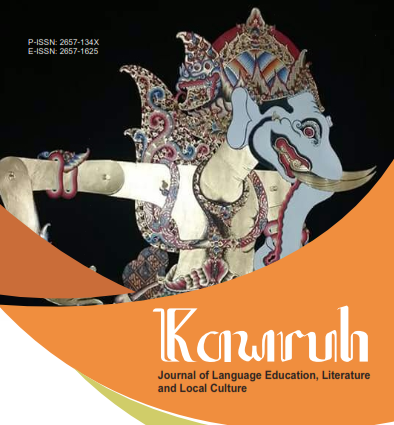Inovasi Pembelajaran Berbasis Animasi 2 Dimensi Untuk Mahasiswa Berkebutuhan Khusus (Studi Kasus Mahasiswa Tuli di Usahid Surakarta)
DOI:
https://doi.org/10.32585/kawruh.v5i1.3388Abstrak
Universitas Sahid Surakarta has accepted students with special needs since 2012 and has been running for the last ten years. Managing students with special needs is challenging because it requires a special effort. Most students with disabilities are deaf. The fact faced during the last ten years is that students with special needs, especially deaf, do not all understand sign language. Not all of them also understand the language of lip movements. They can only communicate using written language. However, their ability to understand sentences is also minimal in the sense of only being able to understand short sentences. Students with special needs have difficulty understanding or digesting long and many sentences. Those conditions affect the process of receiving teaching materials. From the problems faced, solutions are needed for learning innovations for students with special needs. The innovation is to make learning media based on 2-dimensional animation. The production of this learning media was monitored and evaluated by the Directorate of Learning and Student Affairs (Belmawa) of the Directorate General of Higher Education, Research and Technology (Ditjen Diktiristek) last September 2022. The learning media that have been made have also undergone a process of testing, improving, and improving, which takes more than two semesters.Unduhan
Referensi
Aswat. 2011. Menggambar Dengan Corel Draw:Dari Foto Menjadi Vector. Jakarta: Mediakita.
Delila Khoiriyah Masuri. 2020. “Pengembangan Media Pembelajaran Video Animasi Materi Volume Bangun Ruang Untuk SD Kelas V.” Jurnal Penelitian Pendidikan Guru Sekolah Dasar 8 (5): 1–11.
https://ejournal.unesa.ac.id/index.php/jurnal-penelitian-pgsd/article/view/35876.
Disabilitas, UU. 2016. Undang-Undang No 8 Tahun 2016 Tentang Penyandang Disabilitas.
Fahrurrozi; Mohzana, Muh. 2020. Pengembangan Perangkat Pembelajaran: Tinjauan Teoretis Dan Praktik. Surakarta: Insan Institute.
Husin, Lauditta Soraya. 2020. “Subjective Well Being Pada Mahasiswi Tunanetra.” Psikoislamedia : Jurnal Psikologi 5 (1): 54. https://doi.org/10.22373/psikoislamedia.v5i1.7360.
K, Ichwan. 2015. Membuat Metode Pembelajaran Dengan Adobe Flash CS6. Yogyakarta: Andi.
Muhtadi, Ali. 2008. “Pendidikan Dan Pembelajaran : Suatu Tinjauan Teoritis Dan Praktis.” Majalah Ilmiah Pembelajaran 1 (4): 54–70. https://journal.uny.ac.id/index.php/mip/article/view/6877/5910.
Ningsih, Fitri, and Suryane Sulistiana Susanti. 2019. “Psychological Well-Being Pada Penyandang Disabilitas Fisik Physicological Well-Being of Physical Disability People.” Jurnal Imiah Mahasiswa Fakultas Keperawatan Universitas Syah Kuala IV (1): 87–94. http://jim.unsyiah.ac.id/FKep/issue/view/449.
Sannakkanavar, Prakash. 2022. Educational Technology. Ashok Yakkaldevi.
Sapriyah. 2019. “Peran Media Pembelajaran Dalam Proses Belajar Mengajar.” In Diklat Review : Jurnal Manajemen Pendidikan Dan Pelatihan, 2:470–77. https://doi.org/10.35446/diklatreview.v3i1.349.
Sirait, Matias Julyus Fika. 2022. Pembelajaran Berbasis Multimedia. Edited by Matias Julyus Fika Sirait. Medan: Yayasan Kita Menulis.
Sisdiknas, UU. 2003. Undang-Undang Tentang Sistem Pendidikan Nasional Nomor 20/2003.
Unduhan
Diterbitkan
Cara Mengutip
Terbitan
Bagian
Lisensi
Hak Cipta (c) 2023 Ahmad Khoirul Anwar

Artikel ini berlisensiCreative Commons Attribution-ShareAlike 4.0 International License.
Authors who publish with the Kawruh: Journal of Language Education, Literature and Local Culture agree to the following terms:
- Authors retain copyright and grant the journal the right of first publication with the work simultaneously licensed under a Creative Commons Attribution License (CC BY-SA 4.0) that allows others to share the work with an acknowledgment of the work's authorship and initial publication in this journal.
- Authors are able to enter into separate, additional contractual arrangements for the non-exclusive distribution of the journal's published version of the work (e.g., post it to an institutional repository or publish it in a book), with an acknowledgment of its initial publication in this journal.
- Authors are permitted and encouraged to post their work online (e.g., in institutional repositories or on their website) prior to and during the submission process, as it can lead to productive exchanges, as well as earlier and greater citation of published work.

